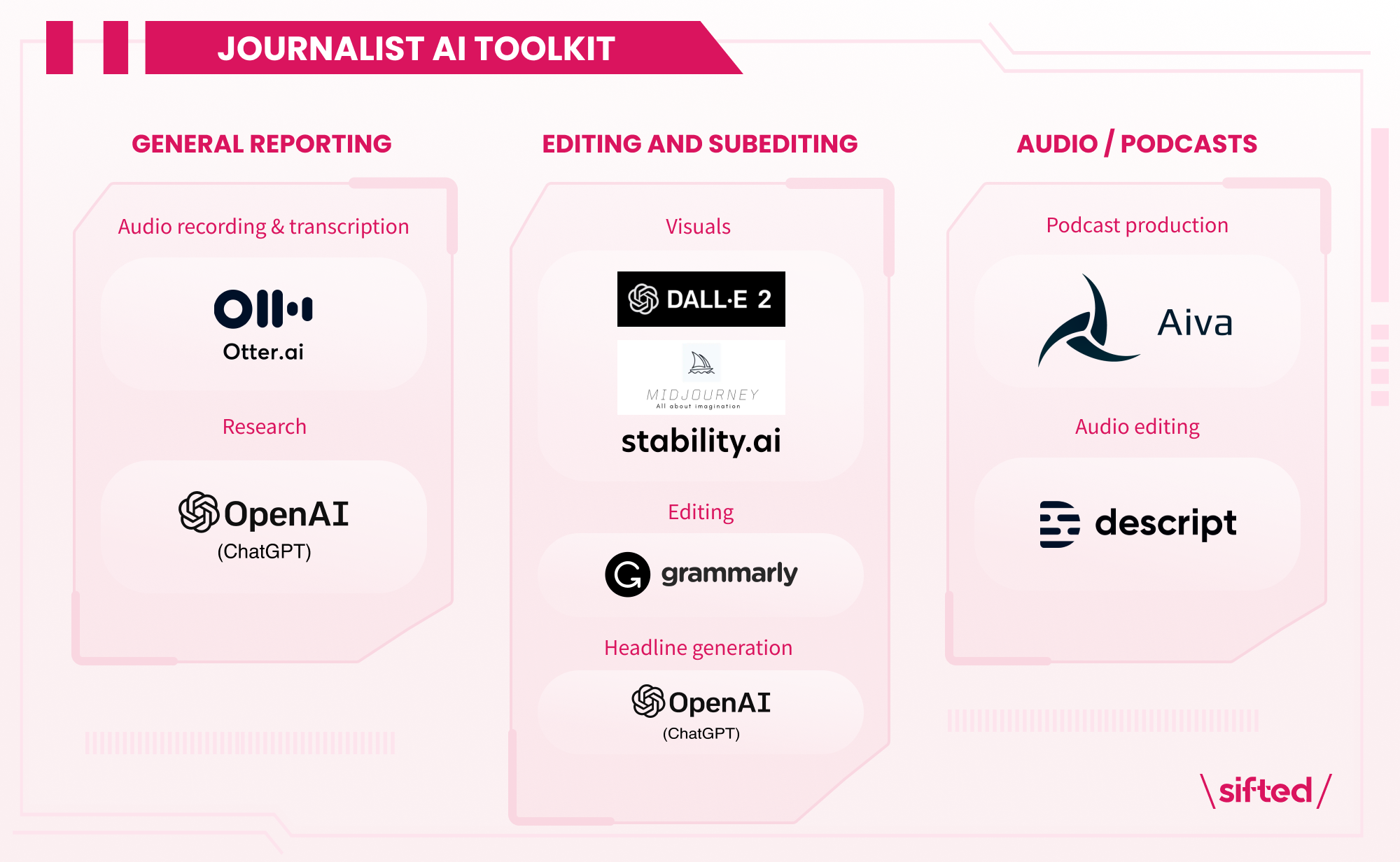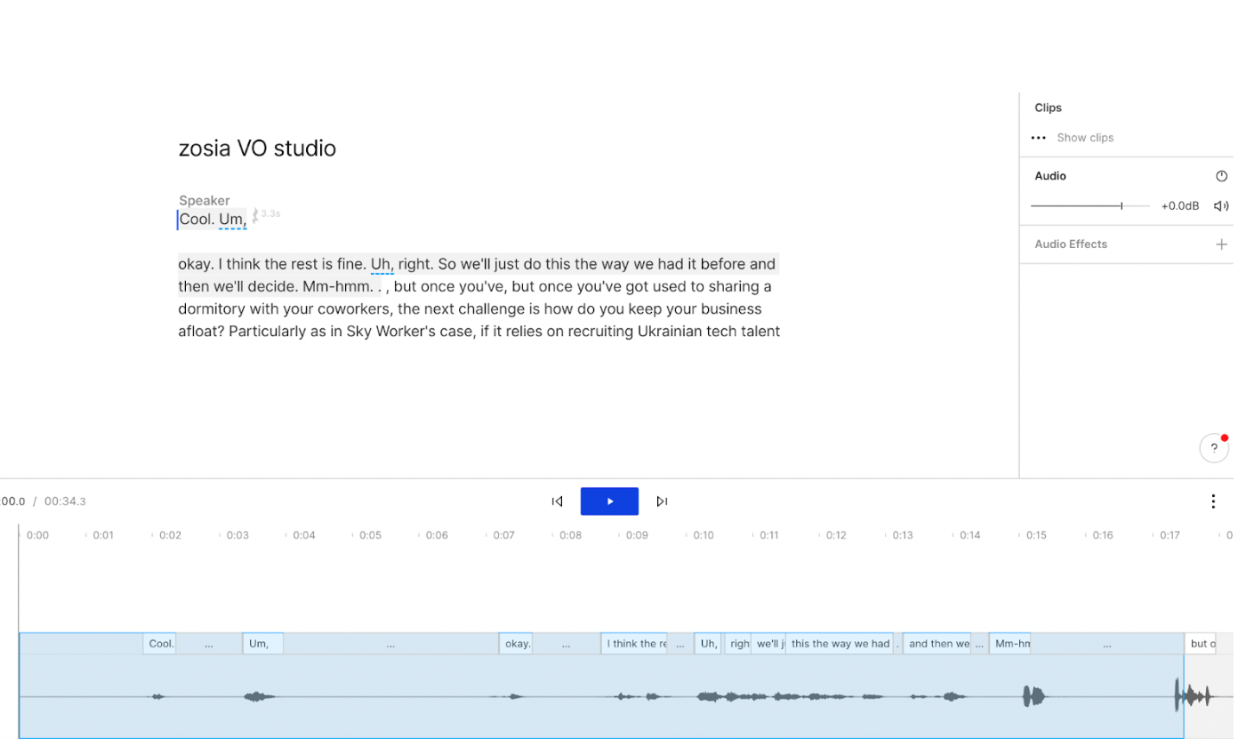Generative AI is tech’s latest hype child. Like any emerging trend, the initial uses are more gimmick than substance — we all remember the beer-drinking apps of the early App Store.
But the wide availability of powerful large language models to the public is something we can’t ignore as journalists. These tools have the potential to help us provide even better reporting to our readers and do our jobs faster (if not yet more accurately).
We’re not the only journalists paying attention. BuzzFeed said last month it would use OpenAI’s ChatGPT “to enhance its quizzes and personalise some content for audiences”.
But which GenAI tools do we think are actually useful to journalists on a daily basis? After weeks of testing and researching dozens of tools, here's what we think a journalist’s AI toolkit should look like.
Our list

You’ll notice there are some OG AI tools in here — notably spell checker Grammarly and transcription software Otter.ai. Despite them being in the market for a long time, we haven’t seen anything better. If it's not broken, don’t fix it.
The most surprising thing for our readers might be how we’re using ChatGPT for research. It’s most useful when we're swotting up on a technical topic or need additional context around a subject area.
For example, we might be writing about startups that are applying AI to quality control in manufacturing settings. With Google, it would take 15 minutes to find a few names. With ChatGPT, we can get a list of a few names in two seconds, and then use other sources to verify those names.
ChatGPT’s also a good place to start when you’re trying to get your head around some tech outside of your expertise. Due to its tendency to make things up it can only ever be a starting point, but if you’re trying to make sense of "optical matrix-vector multipliers” ahead of an interview, ChatGPT is good at putting hard science into plain English. You just have to make sure to fact-check it after.

Multimedia
Beyond the nuts and bolts of journalistic research, generative AI is becoming pretty handy in the generally time-consuming world of multimedia production. Descript — an audio and video editing app that got investment from OpenAI last year — works a bit like Otter.ai in generating transcripts from audio, but also lets you edit the audio from a text document rather than an audio waveform.
This saves loads of time as it’s much easier to edit words by looking at them written out, rather than looking at them represented by some squiggly bumps on a waveform. It also highlights the “umms” and “uhhs”, letting you remove those automatically.

Generative AI is also speeding up the task of finding music for podcasts. If you don’t have the budget to pay a composer to write a score for your episode, you’d previously have to trawl through libraries of royalty-free music in search of a track that suited the right mood you were looking for. This sucked up time, as well as your soul, as you had to listen to endless badly made songs before finding something appropriate.
AIVA is a Luxembourg-based startup that lets you generate songs based on preset styles of music, and even lets you choose the key. Even if you’re not a musician, you can select major keys for more upbeat tracks and minor keys for songs that are sadder or heavier. Our early experience found that we were able to find suitable music much quicker with generative tools like this.
If you want to listen to some of the results, check out our special podcast telling the stories of Ukrainian founders — to an AIVA soundtrack.
Image generation
Finding cool ways to illustrate a story can be a bit of a headache for a tech publication. While some of the founders we cover are working on visually arresting products, a lot are building software products that are pretty boring to look at.
Where we would normally have used a headshot as a top image, we’re now using tools like Stable Diffusion to make graphics to accompany our pieces.

We’re conscious of the questions that come from using generative art and the biases in these models, and so, for example, we’ve made the decision to rule out using prompts that make images “in the style of” living artists. We see using generative AI (ethically) as a way to improve our current offering without it costing the world, and we’re still paying highly talented designers for the work they've always done for us.
What doesn’t really help us
Just as interesting as the companies we’ve listed are the ones we haven’t. Because there are so many AI tools we get pitched that simply aren’t helpful.
Written content generators
Content marketing generators like Jasper are not applicable to us at all. We are writing original, usually proprietary, content, not an SEO-ified piece on Pickleball rules.
That’s why we like tools like Grammarly so much; we’re professional writers and Grammarly gives us autonomy over our expression while still making sure our writing is clean.
This also applies to social content generators. For better or for worse, building a brand as a journalist usually involves being the fastest person to get some spicy quip onto Twitter. GenAI is really not great at writing this kind of content. Just look at what Latte, an EF-backed social asset generation app, told me I should tweet about my dinner with some cool angel investors. No way in hell I am putting that on my Twitter.

Brainstorming tools
There are lots of tools out there that kind of put a skin on text generators like ChatGPT and offer you nice UX ways to brainstorm content. Want to write a blog article? It will give you ideas and a structure. We tried out a few, such as Fermat.
The problem is that our ideas come from talking to people — ie. "Are people talking about GenAI? Maybe we should write an article" — or from news that happens — "What are Monzo’s earnings this year?" So brainstorming about topics with AI isn’t helpful in the least. Neither is any sort of steer on structure; it’s our job as journalists to know how to put together an article.
Look at this example I have with Fermat. I want to think about how to write a story about people laid off from tech companies. But the suggestions here are literally things that every journalist should think about right off the bat.

Don’t tell me how to do my job
Meeting notes
There are a bunch of AI-powered meeting note tools, such as Supernormal, which just raised $10m from some smart people. Otter.ai kind of already serves as meeting notes for our interviews. But journalists' meetings and interviews aren’t really centred around “action points” — we’re trying to glean information. So these tools just aren’t useful.
Buggy summarisation tools
We love the idea of being able to summarise a complicated scientific paper as a way to speed up research, but a lot of the tools out there don’t even hit the minimum viable product level yet. We understand it’s early days for some of these companies so we won’t name and shame, but ultimately experiences like the one shown below are just a waste of our time at the minute.



